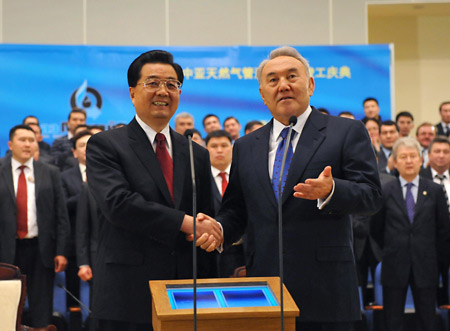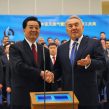
China’s Central Asian Profile Continues Growing
Publication: Eurasia Daily Monitor Volume: 8 Issue: 55
By:

Though largely unnoticed by the media, China continues to expand its economic and therefore political and strategic position in Central Asia. This expansion even includes territorial revisions in China’s favor. In the energy sector Turkmenistan has agreed to sell China 20 billion cubic meters (bcm) more of gas that will be shipped from the Turkmenistan-China pipeline, thus achieving a figure of 60 bcm annually. This means buildng new pipelines and equals more than 60 percent of China’s domestic gas production in 2010. To finance this deal China’s State Development Bank will lend Turkmenistan an unspecified amount of money (World China Times, Taipei, March 3, 2011).
However, the deal may not yet be complete. Reportedly, China is offering to pay $100 to $150 per thousand cubic meters (tcm) far below the European market price of $250 to $400 per tcm. If this deal goes through not only will China be buying more Turkmen gas than Russia, thus weakening Moscow’s leverage on Ashgabat, it also will reduce China’s need to meet Russian price demands in the Russian gas pipeline negotiatoins currently underway which remain stuck over price disputes (The Moscow Times, November 24, 2010).
Meanwhile, this agremeent has strenghtened China’s position in Turkmenistan to the point where its leader, President, Gurbanguly Berdymukhammedov, has stated again just how much Turkmenistan views China as one of its most dependable and strategic partners, an obeisance that Beijing clearly likes to hear from Central Asian leaders (The Golden Age, Ashgabat, March 14; Turkmen TV Altyn Asir, March 14). This deal thus underscores China’s capability to buy up the energy and infrastructure it needs and wants and to displace Russia in Central Asian markets. Similarly, it stimulates other producers there to sell to China. Thus, Iranian Radio reports that Uzbeksitan will build the third line of the Turkmenistan-China gas pipeline and open it by 2013 (Voice of the Islamic Republic of Iran, March 9).
But China is not only talking to these states. During Kazakh President Nursultan Nazarbayev’s recent visit to China agreements were signed on major loans to Kazakh metal companies and for building a gas chemical complex in Atyrau. Both sides also signed a framework agreement on exploiting the Urihktau deposit of raw materials for the gas pipeline from Western Kazakhstan to China and a memorandum of cooperation on constructing a high-speed rail network from Almaty to Astana. However, beyond these deals there are dark suspicions in the Kazakh media and political circles that China forced Kazakhstan to secretly lease land (EDM, March 14, 2011). Although, such reports are unconfirmed, China has recently completed such an arrangement with Tajikistan where Dushanbe actually ceded land to China.
This agreement, allegedly based on a prior accord between the two governments in 2002 that was ratified again in 2010 cedes about 1,000 square kilometers (km) in the Pamir Mountains to China, about 1 percent of Tajikistan, albeit a sparsely settled area. Tajikistan’s government hailed this as a victory because China had actually claimed some 28,000 km and settled for only about 3.5 percent of its claims. Moreover, Shukhrob Sharipov, Director of the Presidential Center for Strategic Studies, argued that, “If we had not decided to transfer the land (at this time), we would not have been able to resist China’s pressure” (Eurasia Insight, January 28; Asia Times Online, January 2). Accordingly, this “rectification” of the borders ensures Tajikistan’s inviolability of its borders, definitively solves its border problems with China, and ensures its stability “for decades to come” (Interfax, January 18; Asia-Plus Online, January 13; Interfax, January 14; Interfax, April 28, 2010).
This deal triggered a strong and public nationalist backlash at the surrender of Tajik territory to China, even if the disputes about it go back to Tsarist times. Perhaps this backlash was triggered more by the fact that between 1,500 to 2,000 Chinese farmers will settle another 2,000 hectares of land beyond the border agreement. According to the opposition, Tajikistan is becoming increasingly economically dependent on China due to its large investment in the area. But worse still, the raw material resources in the land ceded by Tajikistan allegedly equals the entire Chinese investment in Tajikistan to date. Therefore, China has reportedly recouped its investment at no cost to itself and has both the land and its resources as well as maintaining its investments and penetration of Tajikistan. Indeed, Tajikistan represents only the latest example of such border rectifications in China’s relationships with Central Asia. Similarly the charges of cession of land to China could easily cause even more unrest than was discerned in the tightly regulated Kazakh media and political circles. The Paris-based journal, Intelligence Online, accused China of carrying out a policy of “organized annexation of strategic areas” (Online Intelligence, February 17). So, despite official denials, Kazakh policy towards China as well as Chinese pressure on Kazakhstan will probably come under greater scrutiny (Interfax-Kazakhstan, March 4).
These two episodes each show not only the power of China but also the deep suspicion its rise engenders both among Central Asian publics and in their political leadership. Nevertheless, these governments cannot do without Chinese investments and must pay the price for securing them, which includes not only occasional cessions of land to China but also ritual obeisance’s like that of Berdimuhamedov or by the Kazakh pundits who extol China’s development strategy as a possible model for their country (Xinhua, February 28). Clearly China’s burgeoning ties with these states and the implications of the relationship deserve much greater attention because the simmering anxieties about China are carefully concealed behind several masks; but when the mask slips as in the Tajik and Kazakh cases, a most interesting and potentially portentous play is revealed to the spectators.




